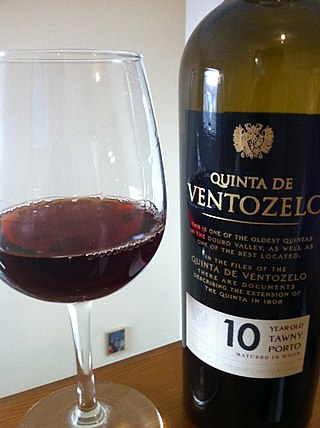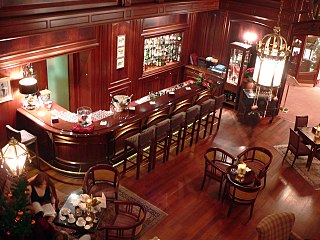
Wine is an alcoholic drink typically made from fermented grapes. Yeast consumes the sugar in the grapes and converts it to ethanol and carbon dioxide, releasing heat in the process. Different varieties of grapes and strains of yeasts are major factors in different styles of wine. These differences result from the complex interactions between the biochemical development of the grape, the reactions involved in fermentation, the grape's growing environment (terroir), and the wine production process. Many countries enact legal appellations intended to define styles and qualities of wine. These typically restrict the geographical origin and permitted varieties of grapes, as well as other aspects of wine production. Wines can be made by fermentation of other fruit crops such as plum, cherry, pomegranate, blueberry, currant and elderberry.

Chardonnay is a green-skinned grape variety used in the production of white wine. The variety originated in the Burgundy wine region of eastern France, but is now grown wherever wine is produced, from England to New Zealand. For new and developing wine regions, growing Chardonnay is seen as a 'rite of passage' and an easy entry into the international wine market.

Brandy is a liquor produced by distilling wine. Brandy generally contains 35–60% alcohol by volume and is typically consumed as an after-dinner digestif. Some brandies are aged in wooden casks. Others are coloured with caramel colouring to imitate the effect of ageing, and some are produced using a combination of ageing and colouring. Varieties of wine brandy can be found across the winemaking world. Among the most renowned are Cognac and Armagnac from south-western France.

Champagne is a sparkling wine originated and produced in the Champagne wine region of France under the rules of the appellation, that demand specific vineyard practices, sourcing of grapes exclusively from designated places within it, specific grape-pressing methods and secondary fermentation of the wine in the bottle to cause carbonation.

Sparkling wine is a wine with significant levels of carbon dioxide in it, making it fizzy. While the phrase commonly refers to champagne, European Union countries legally reserve that term for products exclusively produced in the Champagne region of France. Sparkling wine is usually either white or rosé, but there are examples of red sparkling wines such as the Italian Brachetto, Bonarda and Lambrusco, and the Australian sparkling Shiraz. The sweetness of sparkling wine can range from very dry brut styles to sweeter doux varieties.

Port wine is a Portuguese fortified wine produced in the Douro Valley of northern Portugal. It is typically a sweet red wine, often served with dessert, although it also comes in dry, semi-dry, and white varieties.

Mulled wine, also known as spiced wine, is an alcoholic drink usually made with red wine, along with various mulling spices and sometimes raisins, served hot or warm. It is a traditional drink during winter, especially around Christmas. It is usually served at Christmas markets in Europe, primarily in Germany, Austria, and eastern France. There are non-alcoholic versions of it. Vodka-spiked mulled wine can be found in Polish Christmas markets, where mulled wine is commonly used as a mixer.

A tavern is a type of business where people gather to drink alcoholic beverages and be served food such as different types of roast meats and cheese, and where travelers would receive lodging. An inn is a tavern that has a license to put up guests as lodgers. The word derives from the Latin taberna whose original meaning was a shed, workshop, stall, or pub.

A bar, also known as a saloon, a tavern or tippling house, or sometimes as a pub or club, is a retail business establishment that serves alcoholic beverages, such as beer, wine, liquor, cocktails, and other beverages such as mineral water and soft drinks. Bars often also sell snacks, such as crisps or peanuts, for consumption on their premises. Some types of bars, such as pubs, may also serve food from a restaurant menu. The term "bar" refers to the countertop where drinks are prepared and served, and by extension to the overall premises.

Winemaking or vinification is the production of wine, starting with the selection of the fruit, its fermentation into alcohol, and the bottling of the finished liquid. The history of wine-making stretches over millennia. The science of wine and winemaking is known as oenology. A winemaker may also be called a vintner. The growing of grapes is viticulture and there are many varieties of grapes.
Rakia, Rakija, Rachiu or Raki, is the collective term for fruit spirits popular in the Balkans. The alcohol content of rakia is normally 40% ABV, but home-produced rakia can be stronger.

Burgundy wine is made in the Burgundy region of eastern France, in the valleys and slopes west of the Saône, a tributary of the Rhône. The most famous wines produced here, and those commonly referred to as "Burgundies," are dry red wines made from pinot noir grapes and white wines made from chardonnay grapes.

White wine is a wine that is fermented without skin contact. The colour can be straw-yellow, yellow-green, or yellow-gold. It is produced by the alcoholic fermentation of the non-coloured pulp of grapes, which may have a skin of any colour. White wine has existed for at least 4,000 years.

Wine and food matching is the process of pairing food dishes with wine to enhance the dining experience. In many cultures, wine has had a long history of being a staple at the dinner table and in some ways both the winemaking and culinary traditions of a region will have evolved together over the years. Rather than following a set of rules, local cuisines were paired simply with local wines. The modern "art" of food pairings is a relatively recent phenomenon, fostering an industry of books and media with guidelines for pairings of particular foods and wine. In the restaurant industry, sommeliers are often present to make food pairing recommendations for the guest. The main concept behind pairings is that certain elements in both food and wine interact with each other, and thus finding the right combination of these elements will make the entire dining experience more enjoyable. However, taste and enjoyment are very subjective and what may be a "textbook perfect" pairing for one taster could be less enjoyable to another.

Côte Chalonnaise is a subregion of the Burgundy wine region of France. Côte Chalonnaise lies to the south of the Côte d'Or continuing the same geology southward. It is still in the main area of Burgundy wine production but it includes no Grand cru vineyards. Like the Côte d'Or, it is at the western edge of the broad valley of the river Saône, on the rising ground overlooking the town of Chalon-sur-Saône which is about six kilometers out into the plain. To the north, across the River Dheune, lies the Côte de Beaune. To the south is the Mâconnais. The grapes of the region are predominantly Pinot noir and Chardonnay with some Aligoté and Gamay also grown in vineyards spread over a stretch of 25 kilometers long and 7 kilometers wide of undulating land in which vineyards are interspersed with orchards and other forms of farming.

A wine glass is a type of glass that is used to drink and taste wine. Most wine glasses are stemware (goblets), i.e., they are composed of three parts: the bowl, stem, and foot.
The glossary of wine terms lists the definitions of many general terms used within the wine industry. For terms specific to viticulture, winemaking, grape varieties, and wine tasting, see the topic specific list in the "See also" section below.
Restaurants fall into several industry classifications, based upon menu style, preparation methods and pricing, as well as the means by which the food is served to the customer. This article mainly describes the situation in the US, while categorisation differs widely around the world.

The aromas of wine are more diverse than its flavours. The human tongue is limited to the primary tastes perceived by taste receptors on the tongue – sourness, bitterness, saltiness, sweetness and savouriness. The wide array of fruit, earthy, leathery, floral, herbal, mineral, and woodsy flavour present in wine are derived from aroma notes sensed by the olfactory bulb. In wine tasting, wine is sometimes smelled before taking a sip in order to identify some components of the wine that may be present. Different terms are used to describe what is being smelled. The most basic term is aroma which generally refers to a "pleasant" smell as opposed to odour which refers to an unpleasant smell or possible wine fault. The term aroma may be further distinguished from bouquet which generally refers to the smells that arise from the chemical reactions of fermentation and aging of the wine.
Cava is a sparkling wine of Denominación de Origen (DO) status from Spain. It may be white (blanco) or rosé (rosado). The Macabeo, Parellada and Xarel·lo are the most popular and traditional grape varieties for producing cava. Chardonnay and Malvasia are also permitted. Authorized red grapes are Garnacha tinta, Monastrell, Trepat, and Pinot Noir. Only wines produced in the traditional method may be labelled "cava"; those produced by other processes may only be called "sparkling wines". About 95% of all cava is produced in the Penedès area in Catalonia, Spain, with the village of Sant Sadurní d'Anoia being home to many of the largest Catalan production houses. The two major producers are Codorníu and Freixenet. Cava is also produced in other villages in the provinces of Girona, Lleida, Tarragona, and Barcelona in Catalonia, Zaragoza in Aragon, Badajoz in Extremadura, La Rioja, Araba/Álava in the Basque Country, Navarra and València in the Valencian Community.















